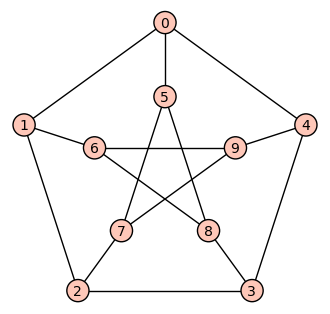"""
Ilija Gavran
"""
|
|
# Sage koristi NetworkX grafove (Python)
import networkx # http://networkx.lanl.gov/index.html
|
|
G = graphs.PetersenGraph()
N = G.networkx_graph()
|
|
N.adj
{0: {1: {}, 4: {}, 5: {}}, 1: {0: {}, 2: {}, 6: {}}, 2: {1: {}, 3:
{}, 7: {}}, 3: {8: {}, 2: {}, 4: {}}, 4: {0: {}, 9: {}, 3: {}}, 5:
{0: {}, 8: {}, 7: {}}, 6: {8: {}, 1: {}, 9: {}}, 7: {9: {}, 2: {},
5: {}}, 8: {3: {}, 5: {}, 6: {}}, 9: {4: {}, 6: {}, 7: {}}}
|
G.show()
|
|
# Zadavanje grafa
d = {0: [1,4,5], 1: [2,6], 2: [3,7], 3: [4,8], 4: [9], 5: [7, 8], 6: [8,9], 7: [9]} # preko rjecnika
G = Graph(d); G
G.show()
|
|
K = networkx.complete_bipartite_graph(12,7) # generiranje pomocu networkx paketa
G = Graph(K)
G.degree()
[7, 7, 7, 7, 7, 7, 7, 7, 7, 7, 7, 7, 12, 12, 12, 12, 12, 12, 12] |
G.show3d()
M = Matrix([(0,1,0,0,1,1,0,0,0,0),(1,0,1,0,0,0,1,0,0,0), \
(0,1,0,1,0,0,0,1,0,0), (0,0,1,0,1,0,0,0,1,0),(1,0,0,1,0,0,0,0,0,1), \
(1,0,0,0,0,0,0,1,1,0), (0,1,0,0,0,0,0,0,1,1),(0,0,1,0,0,1,0,0,0,1), \
(0,0,0,1,0,1,1,0,0,0), (0,0,0,0,1,0,1,1,0,0)])
G = Graph(M); M # zadavanje matricom susjedstva
[0 1 0 0 1 1 0 0 0 0] [1 0 1 0 0 0 1 0 0 0] [0 1 0 1 0 0 0 1 0 0] [0 0 1 0 1 0 0 0 1 0] [1 0 0 1 0 0 0 0 0 1] [1 0 0 0 0 0 0 1 1 0] [0 1 0 0 0 0 0 0 1 1] [0 0 1 0 0 1 0 0 0 1] [0 0 0 1 0 1 1 0 0 0] [0 0 0 0 1 0 1 1 0 0] |
G.show()
|
|
M = Matrix([(-1,0,0,0,1,0,0,0,0,0,-1,0,0,0,0), \
(1,-1,0,0,0,0,0,0,0,0,0,-1,0,0,0),(0,1,-1,0,0,0,0,0,0,0,0,0,-1,0,0), \
(0,0,1,-1,0,0,0,0,0,0,0,0,0,-1,0),(0,0,0,1,-1,0,0,0,0,0,0,0,0,0,-1), \
(0,0,0,0,0,-1,0,0,0,1,1,0,0,0,0),(0,0,0,0,0,0,0,1,-1,0,0,1,0,0,0), \
(0,0,0,0,0,1,-1,0,0,0,0,0,1,0,0),(0,0,0,0,0,0,0,0,1,-1,0,0,0,1,0), \
(0,0,0,0,0,0,1,-1,0,0,0,0,0,0,1)])
G = Graph(M); M # zadavanje matricom incidencije
[-1 0 0 0 1 0 0 0 0 0 -1 0 0 0 0] [ 1 -1 0 0 0 0 0 0 0 0 0 -1 0 0 0] [ 0 1 -1 0 0 0 0 0 0 0 0 0 -1 0 0] [ 0 0 1 -1 0 0 0 0 0 0 0 0 0 -1 0] [ 0 0 0 1 -1 0 0 0 0 0 0 0 0 0 -1] [ 0 0 0 0 0 -1 0 0 0 1 1 0 0 0 0] [ 0 0 0 0 0 0 0 1 -1 0 0 1 0 0 0] [ 0 0 0 0 0 1 -1 0 0 0 0 0 1 0 0] [ 0 0 0 0 0 0 0 0 1 -1 0 0 0 1 0] [ 0 0 0 0 0 0 1 -1 0 0 0 0 0 0 1] |
G.show()
|
|
G = Graph([(1,3),(3,8),(5,2)]) # zadavanje popisom bridova
G.show()
|
|
# za cesto koristene grafove, vidjeti graphs.[tab]
|
|
G = graphs.HouseXGraph()
G.show()
|
|
G.incidence_matrix()
[-1 -1 -1 0 0 0 0 0] [ 0 0 1 -1 -1 0 0 0] [ 0 1 0 0 1 -1 -1 0] [ 1 0 0 1 0 0 1 -1] [ 0 0 0 0 0 1 0 1] |
G.adjacency_matrix()
[0 1 1 1 0] [1 0 1 1 0] [1 1 0 1 1] [1 1 1 0 1] [0 0 1 1 0] |
G=graphs.HexahedralGraph()
G.show()
# G.show3d()
# view(G) - prikaz pomocu LaTeX-a
# latex(G) - generiranje LaTeX koda za prikaz grafa G
|
|
G.clique_maximum(); G.clique_number() # primjer algoritma na grafu, ima ih mnogo
[6, 7] 2 |
# pretrazivanje grafova po nekom zadanom kriteriju
GraphQuery?
|
File: /opt/sage/local/lib/python2.6/site-packages/sage/graphs/graph_database.py Type: <type ‘type’> Definition: GraphQuery( [noargspec] ) Docstring:
|
graph_db_info()
{'graph_data': ['complement_graph6', 'eulerian', 'graph6',
'lovasz_number', 'num_cycles', 'num_edges',
'num_hamiltonian_cycles', 'num_vertices', 'perfect', 'planar'],
'degrees': ['degree_sequence', 'min_degree', 'max_degree',
'average_degree', 'degrees_sd', 'regular'], 'spectrum': ['spectrum',
'min_eigenvalue', 'max_eigenvalue', 'eigenvalues_sd', 'energy'],
'misc': ['vertex_connectivity', 'edge_connectivity',
'num_components', 'girth', 'radius', 'diameter', 'clique_number',
'independence_number', 'num_cut_vertices', 'min_vertex_cover_size',
'num_spanning_trees', 'induced_subgraphs'], 'aut_grp':
['aut_grp_size', 'num_orbits', 'num_fixed_points',
'vertex_transitive', 'edge_transitive']}
|
|
|


.png)
.png)
.png)
.png)
.png)
.png)